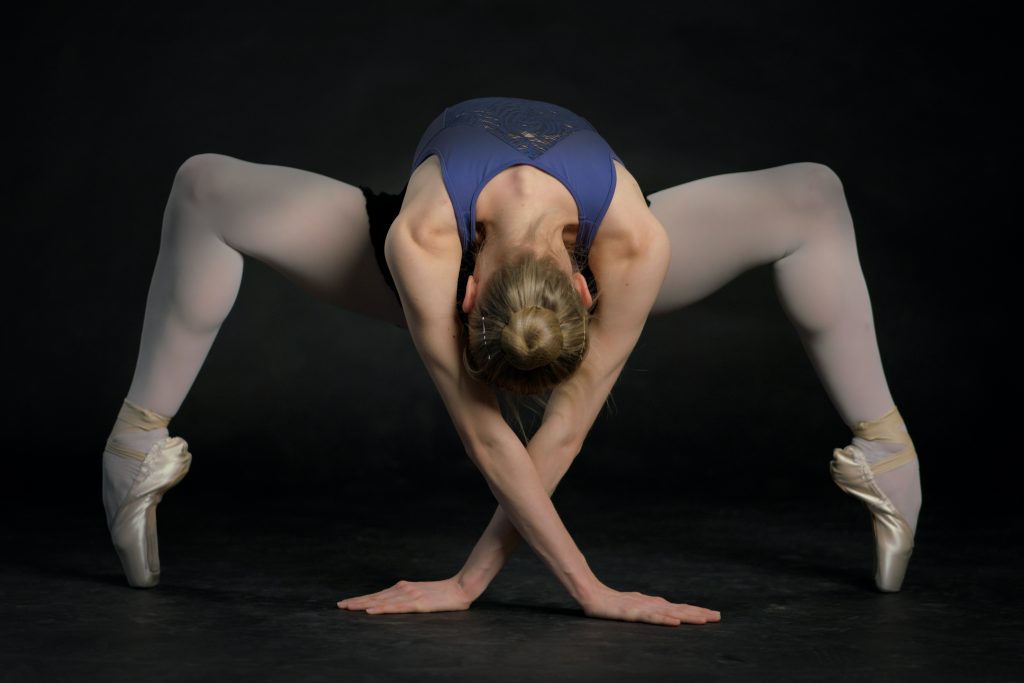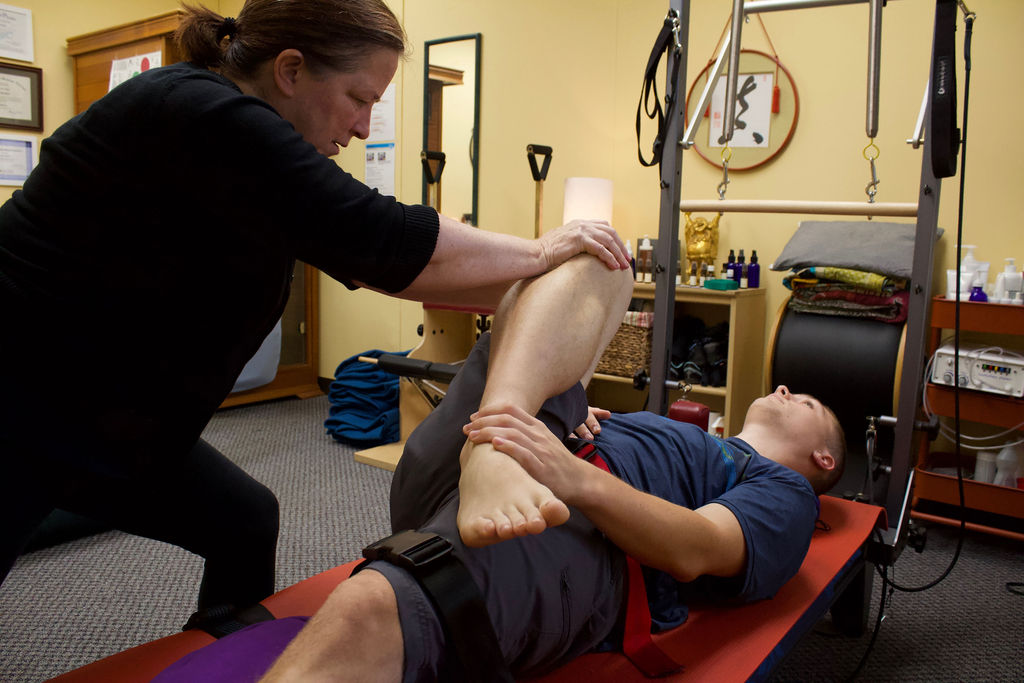
Integrative Bodyworker Janet Matthies explains why athletes dislike stretching after exercise and offers an alternative – flexibility training.
So many active people dislike stretching. They know that they should, but strength training is still emphasized over flexibility.
The regiment of stretching after exercise has been around for a long time and has progressed very little. Stretching has always been something athletes are told to do after a long strength-building workout, before your trainer moves on to the next client. By the end of a workout, you are typically tired and ready to pack it in for the day. So stretching, if done at all, is usually a 5-10 minute robotic routine, done mindlessly and as quickly as possible.
Eventually, some athletes stop stretching altogether and even forget why it is important. Even worse, some form the new opinion that stretching is bad for you. I have been told by competitive runners that stretching injures them, so they just don’t do it.
Stretching has become passé, something that is not looked forward to… EVER! The world of fitness and athletic training has become about 80% strength-building with stretching as an afterthought.
The trouble is that ineffective stretching affects muscles superficially, and can also be unsafe if you are unmonitored. It’s very rare to be taught proper stretching techniques. It seems to me that most athletes are still stretching the same way they were many, many years ago. But why?
There is definitely a better way to stretch, one where you will see the benefit. In this article, I would like to help you to the truth behind flexibility, understand how important stretching is for you, learn the role stretching plays in your workout, and help you think outside the box to incorporate new programs that include stretching throughout your entire workout so you eliminate the need to stretch afterward.
Before we dive in, there is one myth I would like to dispel. As a former athlete, I have insight into the way flexibility training has been in the past, and now, as a trainer, what it looks like today. The attitude in sports typically is that you are either naturally flexible and therefore LUCKY, or you are one of those unlucky athletes who just can’t get to that flexibility ideal.
I want you to know that flexibility is available to ANYONE. The key is simply knowing how to uncover your hidden flexibility. We will talk about options to do that later in this article.
Flexibility: What is it and why is it so important?
Put very simply, flexibility is the ability to move your joints and body parts within their full range of motion.
Flexibility training is important because, as you age, your muscles naturally lose strength, size, and malleability and as a result may grow stiff. This loss of elasticity can cause muscles and joints to tighten up.
For example, in an athletic activity such as cycling, strength is built in your muscles as you cycle. I have found that it is important to counteract this strength building with stretching so the muscles will maintain their greatest range of motion.

In the case of our cyclist, she needs to keep the muscles that bend her over at the waist at their proper length. If these muscles become too long or too short, it will tilt her pelvis either too far forward or too far back and she will develop a poor cycling posture. In either case, she needs to stretch those muscles to bring her pelvis back to the center.
Now, while this relatively minor pelvic tilt may seem harmless enough, and may even improve her performance at the start but if she doesn’t take care to remove the tension created by cycling it will be carried with her to the next day. She may not feel this accumulation of tension at first, but over time the effects will magnify. What starts as a minor pain in the lower back will turn into an injury that will prevent her from riding. In time, this injury will cause a decrease in her performance which will limit the length of time she can continue cycling.
On the other hand, incorporating stretching into her cycling training will directly improve her recovery rate by removing the build-up of tension. This quicker recovery will then translate into uninterrupted training with continued progress.
Flexibility Training: A Stretching Alternative
A great way to eliminate routine and ineffective stretching is to add activities that embed flexibility training throughout your workout rather than tacking it on the end. In various forms of exercise that include flexibility training, you will be always working on a combination of flexibility and strength the entire time you are practicing.
Cross-training that includes flexibility training is a great additional thing to do for many reasons including emotional, spiritual, and physical benefits. For emotional health benefits, try incorporating breathwork like you would in Pilates, Yoga, and Infinity Bodywork. For spiritual healing benefits, meditation is a great tool for improved concentration and focus. Physical benefits include gaining access to a wider range of muscles.
Last but not least, all these programs contain built-in flexibility work. Most of these programs even allow you to evolve a self-led program at home in lieu of scheduling time yet another class or private appointment. This kind of ‘cross-training’ could include:
- Infinity Bodywork Resistance Training
- Ki-Hara Resistance Training
- Meridian Flexibility and Strength Training
- Yoga
- Ballet Bar Workouts
- Pilates
- Tai Chi
- Qigong
Many professional athletes strategically cross-train depending on their eventual goals. Football players take ballet to strengthen their knees, ankles, and feet. Golfers are scheduling Pilates sessions to build core strength and balance unevenly used muscles. Almost everyone has tried some kind of yoga class whether it is Power Yoga, Yoga for Golf, Kundalini Yoga, or Shadow Yoga (with no downward-facing dogs). Resistance Flexibility and strength training have also become very popular in the world of swimming since Dara Torres claimed it is her secret weapon, keeping her competitive at twice the age of her fellow Olympians in 2008. There are a lot of options out there and you owe it to yourself to discover what works for you. Don’t settle for the same old routine!
Understanding New Flexibility Training

An effective flexibility program would combine a perfect balance of your sports-specific strength requirements and flexibility. This plan would also be based on the intensity of your daily workout. The more intense the workout, the more vigorous the flexibility training process will be.
A good test to see if you are doing enough flexibility training is to pay attention to how quickly you recover after intense practice. If you are remaining sore for longer than 2-3 days then you would probably benefit from spreading out your activity and finding a training balance that incorporates more flexibility. As in the case of our cyclist, shorter recovery rates will increase your training effectiveness.
Most people don’t know this, but matching the amount of stretching you do with the amount of strength or exercise/movement you do is an important ingredient for stretching success. In the example of our cyclist, her stretching program will vary according to her goals. If she is a casual cyclist, she will need less stretching. But if she is a competitive rider aiming to improve her time, then stretching daily will improve her performance.
Here are some reasons for you, as an athlete or even a desktop warrior, to incorporate some flexible cross-training programs into your routine.
- Increased flexibility and strength
- Reduced risk of injury
- Increased recovery time from injury or from intense training
- Increased muscle tone
- Improved overall functional movement
- Reduced back, shoulder or neck pain
- Complete entire body workout
- Improved overall posture
- Improved performance
What Kinds of Options Are Out There for Me?
Private Training
A private session is a great idea if you have very specific needs and training requirements. Why not get private insight into your very own body disposition – strength-wise and flexibility-wise? If you are armed with your specific patterns and needs, it will help you navigate the myriad of class options when you are selecting a new, interesting workout option. Be exciting but be safe at the same time!
Group Training
A group class is perfect if you are fit and know your own body very well. Lots of programs are tailored specifically to a sport so choosing a class is pretty easy. If the class names seem mysterious just ask the staff before enrolling and find out about the different teachers’ experiences. Sometimes that can make all the difference in the world. I know I have a special place in my heart for soccer, and most of my fellow practitioners have other experiences that could be very relevant to your choice.
Closing Thoughts
I believe the reason why people dislike stretching so much is that it’s not effective for them. They haven’t been trained to stretch well and it is rarely strategic or done to enhance their goals. If flexibility training were better understood and taught, I think people would be breaking down the doors to include this important work on a regular basis.
At Infinity Bodywork our Asian-Inspired, Western Technique program utilizes modern fitness advancements in our performance training, along with Modern Traditional Chinese Medicine theory to design our programs. Flexibility training at Infinity Bodywork is a fun interactive way to incorporate flexibility back into your regular workout routine.
Effective, well-taught flexibility training can have amazing health benefits. Included in our program are self-stretching techniques, a deep tissue massage technique called “mashing,” assisted stretching and a personality-typing evaluation to help you be the best you can be.
Please feel free to share your experience with flexibility, good, bad, or other – as I mentioned, I have seen and heard almost everything! The comments section below is waiting just for you, talk to you again soon!
Janet Matthies
5th August 2014
Janet Matthies
Related posts
2 Comments
Leave a Reply Cancel reply
Categories
- Flexibility & Strength (13)
- Healing for Meridians (10)
- Holistic Lifestyle (5)
- Lymphatic Drainage (7)
- Massage (4)
- Meridian Archetypes (19)
- Spiritual (1)
- Traditional Chinese Medicine (12)


[…] in their workout routine. Infinity’s flexibility and strength training can improve performance in any sport or activity. It can create flexibility in even the most stubborn of muscles. It builds strength in neglected […]
[…] in their workout routine. Infinity’s flexibility and strength training can improve performance in any sport or activity. It can create flexibility in even the most stubborn of muscles. It builds strength in neglected […]